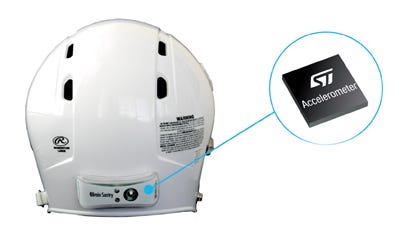Accelerometers: New Weapon in the Fight Against Head Injuries
October 16, 2013
In the past couple of years, researchers have increasingly warned that sports-related head injuries could leave athletes disabled later in life. For example, a study last year by researchers at the National Institute for Occupational Safety and Health found that professional football players had triple the risk of dying from diseases that destroy or damage brain cells than other people and a four times greater risk of dying from Alzheimer's or amyotrophic lateral sclerosis (ALS, or Lou Gehrig's disease). In short, head injuries today could mean debilitation tomorrow.
|
An accelerometer embedded in an impact sensor monitors the strength of collisions to the head. |
In an effort to track the severity of head injuries and reduce the incidence of sports-related brain injuries, Brain Sentry (Bethesda, MD) has designed the Brain Sentry impact sensor, a compact device that sticks to the back of any helmet and enables coaches, trainers, and doctors to monitor players on the field. At the heart of this device is a low-power, high-g triaxial accelerometer, a MEMS-based device manufactured by STMicroelectronics (Geneva, Switzerland) that accurately measures acceleration in all directions produced by collisions.
Accelerometers work like a spring with a weight attached to the end of it, explains Michael Markowitz, director of technical media relations at STMicroelectronics. Under static conditions, the weight pulls the spring to a certain level and then rests there. However, collisions, or changes in momentum, force the spring to move, and that movement is measured to determine the severity of a collision. In other words, the severity of the collision or impact influences the amplitude, or the size, of the change in the spring. "For example, if you have a small collision, or a small change in momentum, the spring moves only a little bit," Markowitz notes. "But if you have a big collision, or a big change in momentum, the spring moves quite a bit. Using capacitance, we measure the amount of movement on the spring, enabling us to deduct how severe the collision was."
Used to ensure accurate measurements, the MEMS-based accelerometer is manufactured using a semiconductor process, Markowitz says. "However, rather than simply etching away material and creating a well in the wafer, as would occur in a typical semiconductor process, the accelerometer is a semiconductor component that can move. And while traditional semiconductor devices take advantage of many unique electrical properties of semiconductor materials, MEMS devices also takes advantage of the mechanical characteristics of semiconductor materials, such as silicon's tensile strength."
"The accelerometer," according to Markowitz, "is not a diagnostic tool in the sense that if someone has a collision of a certain magnitude, we know that they have suffered a concussion. Rather, it's meant to be more of an indicator of collision impact." Thus, if someone has experienced a collision of a certain magnitude, the accelerometer provides data indicating that the person should be examined for concussion.
|
Based on an accelerometer, motion sensors, and microcontrollers, an airbag bicycle helmet inflates in response to collisions. |
Going a step further is a bicycle helmet developed by Hövding (Malmö, Sweden), a device that is designed to protect the head against injury. Incorporating an embedded accelerometer, motion sensors, and microcontrollers manufactured by STMicroelectronics, this airbag-like device is worn around the neck like a scarf, responding to collisions in a tenth of a second by inflating to form a hood around the cyclist's head and neck. Its integrated sensors detect both linear and angular motion in all three dimensions and recognize complex movements. To determine an accident condition, the sensor system relies on algorithms that are culled from a database of movement patterns recorded during hundreds of normal cycling and simulated accident situations.
Accelerometer-based technologies are surely welcome news not only to bicyclists but also to linebackers and running backs. For more stories on smart helmets and sports safety, visit Qmed and Medtech Pulse.
To learn more about sensor applications, attend a seminar on "Advanced Applications of Sensors in Medical Devices" on February 12 at MD&M West in Anaheim, CA. |
Bob Michaels is managing editor of Medical Product Manufacturing News.
About the Author(s)
You May Also Like



